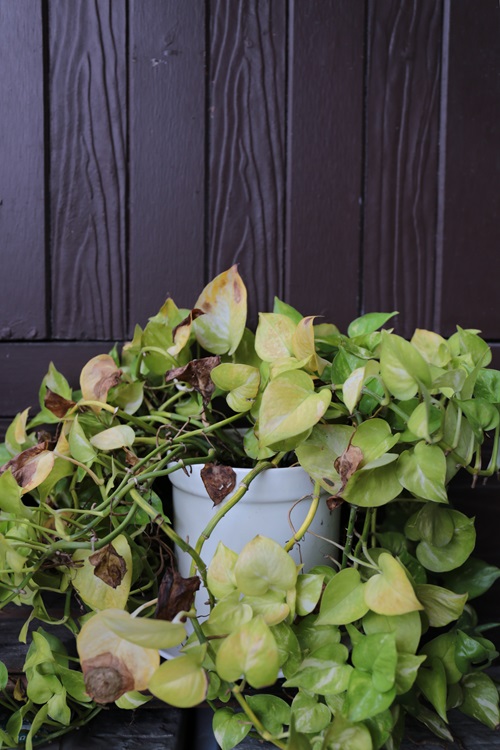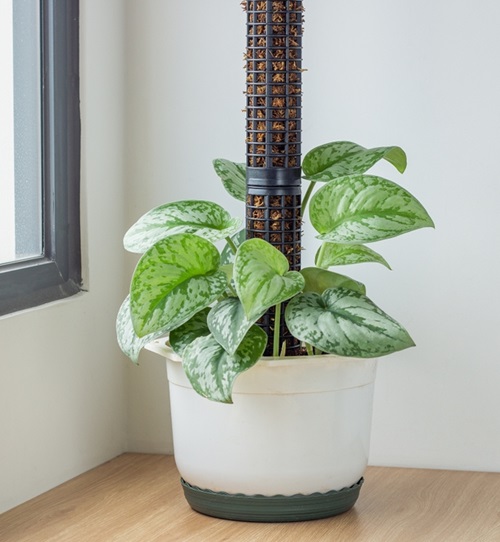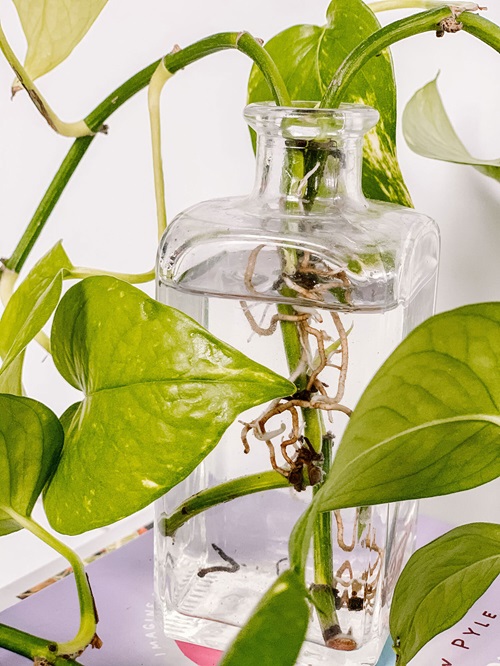Here are the most common Pothos Growing Mistakes everyone must avoid to ensure the plant thrives for years to come!
Pothos is one of the easiest houseplants to grow in the plant world, but still, it doesn’t forgive some mistakes that many plant growers do. If you’re one of them? Discover how to avoid that below!
Learn How to Grow a Pothos as a Tree in this post
Common Pothos Growing Mistakes
1. Growing it in a Very Big Container
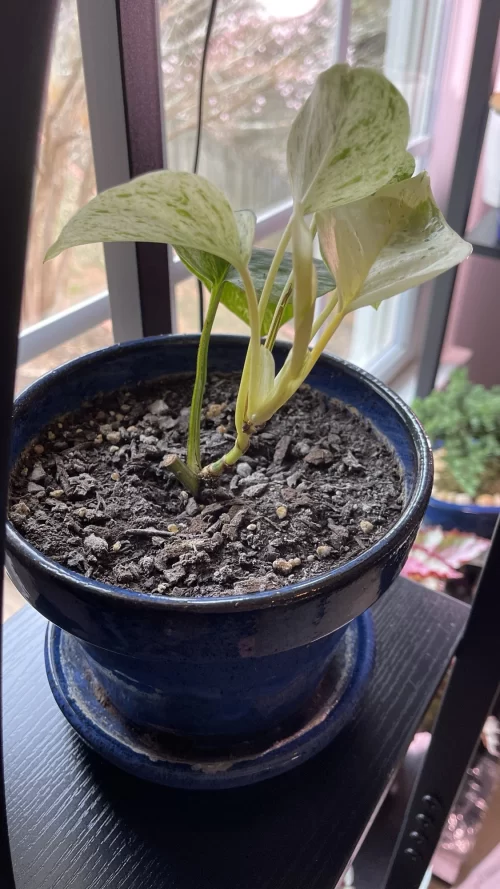
Using an oversized pot for your Pothos can harm its health for several reasons. Firstly, a larger pot holds more volume of soil, therefore retaining more moisture. This consistent excess moisture can lead to root rot, a common issue in Pothos plants.
It also means the plant may focus more on downward growth rather than top growth, leading to less vigorous leaf development.
The best is to go for a pot size maximum of 1 or 2 sizes more than the plant’s rootball.
2. Using a Garden Soil
Though using 100% garden soil might not impact the health or growth of the plant drastically, it may still hinder its development to some extent, especially if it’s not loamy and well-draining. Also, there is a chance of soil-borne diseases!
It is best to opt for a soilless growing medium but if you want to use the garden soil anyhow, work on improving its texture and sterilize it. Make it better by adding soil amendments like coarse sand, peat moss, perlite, compost, or vermiculite to it.
3. Ignoring the Signs of Stress
Yellowing, droopy, and softer leaves and stems may indicate overwatering or poor drainage, while brown, papery, and brittle foliage suggests low humidity or underwatering.
Similarly, leaf burn and edges turning brown can be a sign of overfertilization. If you notice its leaves turning pale and lusterless and slightly burnt, this can be due to too much sun exposure.
Pay attention to these signs and adjust your care routine accordingly. Trimming unhealthy leaves regularly can redirect energy to healthier parts of the plant.
Discover Pothos Leaves Curling with Reasons and Solutions
4. Neglecting Regular Cleaning
Pothos leaves can accumulate dust particles over time, hindering their ability to photosynthesize properly. If you never wipe the leaves with a soft, damp cloth, it’s a big pothos growing mistake to correct.
This simple task not only enhances the plant’s appearance but also supports its overall healthiness.
5. Lack of Support
Pothos are known for their climbing habits. Without proper support, they may become unruly and less aesthetically pleasing. Unless you want your pothos to trail, it’s to provide it the support of a trellis, moss pole, or bamboo stick. One interesting fact to note here is when pothos are trained upward; they grow bigger leaves.
18 Fantastic Pothos Trellis Ideas You Can Easily Make
6. Incorrect Fertilization
Fertilizing less is always more rewarding than fertilizing more in the case of easiest houseplants. Go for a balanced liquid feed and dilute it to 1/4 of the recommended strength provided by the manufacturer.
Fertilize once every 3 to 4 weeks and watch the plant thrive! Drenching the moss pole supporting your pothos plant is one amazing hack to feed this plant 🤩 consistently. Try it!
Note: Reduce or eliminate fertilization in winter if you live in a cold climate.
7. Ignoring Seasonal Adjustments
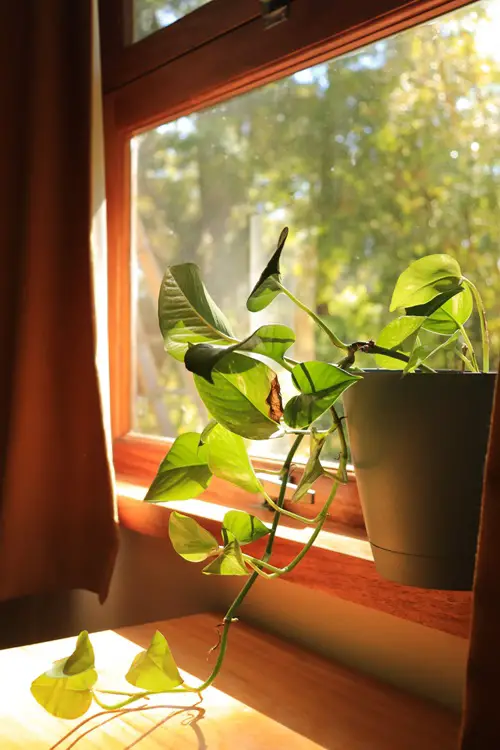
Pothos, like many plants, may have changing needs during different seasons. Growth rates can slow down in the winter, and the plant may require less water and fertilizer. Also, while keeping the plant close to a window, ensure the leaves don’t touch the glass, which may result in scorched foliage.
Make sure the plant doesn’t catch cold drafts and when it rains and the weather becomes humid, reduce watering. Similarly, in summer, save it from the powerful sun and hot air, especially if you live in a warm climate.
Read about Pothos Leaves Turning Yellow: Reasons and Solutions
8. Not Pruning
If your pothos plant is leggy and you have never ever pruned it, it’s a big mistake. If not regularly, it’s required to trim your plant occasionally; it helps maintain a desired shape, encourages new and bushier growth, and eliminates diseased or damaged parts. Neglecting pruning can result in a leggy, messy appearance over time.
Read about Tips on How to Turn Leggy Pothos Plant Bushier
9. Using Hard Water

Pothos plants are sensitive to the mineral content in water. Watering them overhead with hard water containing high levels of minerals, such as calcium, can lead to leaf discoloration and the formation of a white crust on the soil surface.
If you have a hard water problem, use filtered, RO, or distilled water to prevent mineral buildup in the soil and on the surface of leaves.
10. Neglecting Pest Infestations
Pothos plants are generally hardy, but they can still infected by pests such as spider mites, mealybugs, and scale insects. Overlooking signs of pest infestations, such as webbing, leaf curling, or tiny insects on the leaves, can damage your plant in a matter of time.
Regularly inspect your Pothos, especially the undersides of leaves, for pests and take prompt action.
11. Overlooking Rootbound Conditions
Pothos plants are known for their adaptability but can become root-bound if not periodically re-potted. Look for the signs of roots coming out of the drainage holes at the bottom or topsoil – it indicates that the plant needs re-potting soon.
Note: Use a container that’s one size bigger than the old pot, not more than that, or if you don’t want to increase the pot size, gently trim the roots.
Check out Common Pothos Plant Problems and Their Solutions
12. Keeping it in Abject Darkness
Pothos might be a champion of surviving low light conditions, but it needs indirect light and a bit of sun exposure every now and then – but that doesn’t mean you should keep it in direct sunlight all day long.
Finding the right balance is the key here – make sure it gets plenty of indirect or filtered light.
13. Not Changing Water Regularly
While growing pothos in water, it is important that you change it regularly. Stagnant water can lead to algae formation, which competes with the plant for nutrients and light.
Old water can harbor harmful bacteria and fungi, which may cause root rot and other diseases.
Pro Tip: For optimal health, change the water once every 5 to 7 days. This frequency keeps the water fresh and oxygen-rich.


